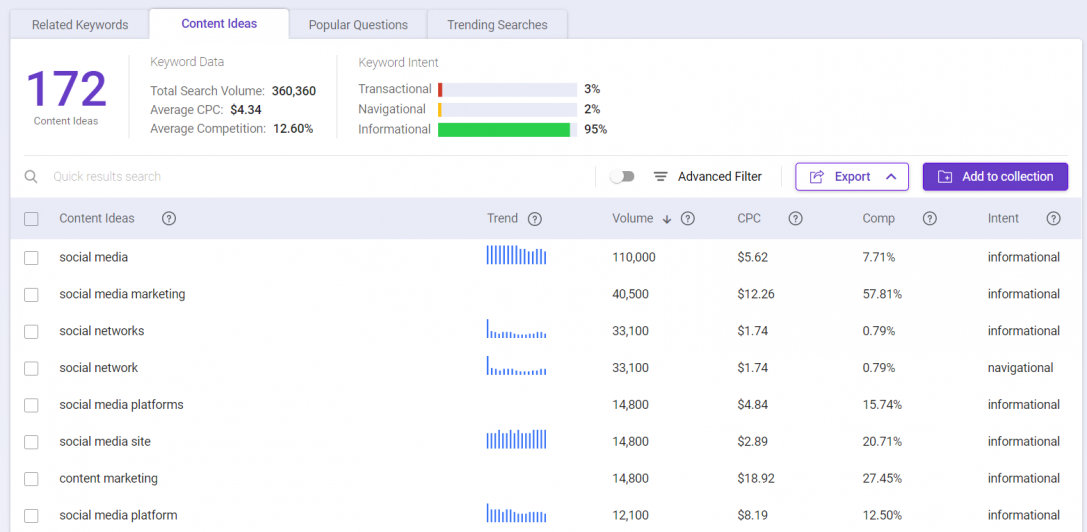There's too much content to be created at times. Hence, many content marketing teams are outsourcing content writing to other people. This guide will show you how you can outsource your content out
Content marketing is massive!
So massive that one person wouldn’t be able to handle it alone.
As a content marketer, if you really want to reach a large following, your content production must be immense.
There’s social media posts, email marketing content, website landing pages, blog posts, and more.
How would you manage everything alone?
There’s just too much content you need to create.
And we’re only human.
We’re limited by several factors like deadlines, writer’s block, experience in certain writing fields, etc.
Thus, you should consider outsourcing content writing.
It’s really cool to outsource some content marketing to other people who’ll get the job done.
Then you can focus on other important issues like website management.
Many content marketing teams are already doing this.
Now, what is the best way to outsource content writing?
Read on to find out!
How To Outsource Writing
Outsourcing content to other professionals is one of the most effective strategies.
However, there are several steps you must apply to lay the groundwork for all future outsourcing projects.
Without these outsource content writing strategies, even the best content workflow designs might not keep everyone on track.

But let’s not go into much detail about that now.
Here’s a comprehensive list of all the steps you must follow for the best outsource writing strategy.
Know What You Need
If you’re planning to outsource content and spend resources on it, you’ll definitely want results.
But to get decent content written, you must have a fairly good idea of what you want to be included in your final content piece.
Where possible, you want to go as far as to picture exactly what you want your final piece to be before you even think of hiring a writer.
Therefore, ensure you know what your needs are upfront before you even consider outsourcing writing.
So, start by creating a content marketing strategy first and assess which writing skills your team already has.
Afterward, you’ll know what to outsource.
You’ll want to set goals for your content marketing strategy to give you a clear focus on what you’ll need going forward.
For instance:
- If you plan to boost organic traffic, you’ll want to focus on educational articles, press releases, and research papers
- To generate leads, you’ll want to create product-focused blog posts, eBooks, and whitepapers
- To drive sales, you’ll need landing pages and newsletters with special offers
In addition to having a strategic focus, you can help your writers to understand better how product-oriented your content should be and how best to optimize it for specific goals.
Define Your Audience
As for defining your audience, you must understand their core demographics. Go beyond the basics as well.

Start by researching and defining specific niches that lie within your general audience.
Understand your audiences’ key pain points and how your products/services can help solve their issues.
Finally, determine how best your audience will interact with your business by fleshing out the most relevant content with buyer personas.
These insights should help you determine the best topics, focus keywords, and writing styles focused on your target audience.
Have Content Ideas
Admittedly, you cannot claim to have a clear outsource writing strategy without a semantic core.
You should organize your topic/keyword strategy and how best to improve your ranking potential moving forward.
Your semantic core should help you choose optimized topics and create content ideas that appeal to your target audience and reach your specific goals.
BiQ Keyword Intelligence is an excellent tool for providing content ideas that allow you to create great blog posts.
You can use the Content Ideas feature in Keyword Intelligence to determine the best keywords and phrases that prove to be a hit with your readers.

BiQ’s Keyword Intelligence will also provide you with critical data and metrics to decide which topics to focus on.
You also want to keep an eye on what’s trending and how best your topics fit into them to capitalize on audience engagement.
Create A Content Calendar
Now that you’re clear on your content formats, goals, marketing channels, and respective funnel stages, you can create a content calendar that’s optimized for your outsource writing needs.
At this stage, it’s critical that your content calendar doesn’t interfere with your other publishing plans.
Therefore, ensure you’ve got all bases covered and that no publishing plans crash.

Most content marketers prefer using Excel sheets and other productivity tools to set out their content plans and calendar.
An Excel sheet details the following information for each individual item:
- The type of content
- The topic
- Marketing channels to promote your content
- Deadlines and publication dates
- Task owners and other team members involved
- The goals set for your post
If you’re planning to pay to have someone write your content, you’ll want to ensure that the finished product is not only high-quality but also about the specific subject you were looking for.
You’ll soon realize that it’s no good just giving a writer your content title and asking them to write 2000+ words on a specific subject.
The chances are that they’ll not follow a specific framework or themes you should be targeting.
Therefore, you must ensure you give your content creator very detailed instructions on how you want your paper to be written to get your desired results.
Set A Budget
By this stage, you should have an idea of what type and how much content you want to outsource.
With this information, you’ll have a better idea of how much you may need to spend on each piece before entering negotiations with writers.
Your budget can also influence which writers you hire, how long your pieces will be, and the critical processes involved in the creation process.
With a budget in mind, you’ll be able to understand the most viable options to budget for and ones to avoid.
Ideally, having a clear budget will let you determine how much you can allocate to individual projects and content creators.
Write A Detailed Brief With Instructions
Having a strong, detailed brief is critical for communicating what you expect from your writers, including who your audience is, how long the piece should be, and what keywords to target.
It’s no good giving a freelancer your content title then asks them to create 2000+ words on a particular niche.
Such content almost never follows the framework you intend to use.
Therefore, you must provide your content creators with very detailed instructions for them to understand better what you’re looking for.

Here’s what you need to include in your content instructions:
1. Overall Point Of The Content Piece
Generally, you want your content writer to understand better what you’re trying to achieve from your content.
You’ll want a writer who knows and understand what you aim to achieve from your content and strive to meet your preferences in the most comprehensive way possible.
2. Total Word Count
Most freelance writers usually stick to the word count you request.
So, provided you’ve got a good freelancer and provide them with detailed and specific instructions, you should be fine.
Of course, you’ll reiterate to your writer to focus on quality over quantity.
You can give a little leeway when it comes to content word count.
If you ask for 2000 words, you can allow for +/- 10% words.
Therefore, anything ranging between 1800-2200 words should be acceptable.
You’ll still end up editing some bits of the posts anyway.
You shouldn’t focus much of your attention on this.
But all the same, it’s still important.
3. Headings
Most website owners actually write all the headings they want to be included in their posts.
These should also include the topic and keyword research.
This will give your writer a good indication of what your heading section should be about.
You should also provide some leeway to allow for better-optimized headings from your writers if possible.
They don’t necessarily have to be your final headings.
Still, they should be specific enough that the writer knows exactly what you want.
4. Details for Each Section
In this section, you’ll provide a brief about what you want to be written under each title and subtitle.
Write a few paragraphs that will explain everything you want to be included in your post and how to write it.
For example, you may want 2 or 3 lines per paragraph or want between 50-100 words in your introductory section.
Explain to your freelancer why you want to include specific details for your writing format.
Find And Choose The Right Freelancer/Agency
As obvious as it might be, when looking for a freelancer/agency to write your content, you must be very picky about who you add to the team.
Ensure you make it very clear to them what you’re looking for and that you want an expert in that specific niche.

Don’t fall for the con used by “professional content writers” who claim they can write about any topic.
You want an experienced, certified, and professional writer who actually works in that specific industry.
Sure, you’ll get a lot of trash applications.
But you’ll also get a few good ones in there.
So, ensure you read through all applications and check all portfolios to check if they’ve got the experience and certifications to match your writing needs.
It’s your job to choose the right type of writer/agency that will create content according to your writing needs.
Zerys is probably one of the best outsource content writing agencies you can use to plan your content and find top writing talent.
Zerys is the best platform to create custom content, eBooks, and white papers your readers will enjoy reading.
Request For Revisions If Needed
One thing is for sure, even the best freelancers or agencies at some point don’t create content as you’d want them to.
So, now that you’ve gotten your article or blog post back, your next task is to go through it carefully.
Of course, you’ll need to do some editing for the final post to match your company writing format.
Occasionally, you’ll be lucky enough to find a freelancer/agency that just knows what it is you want and gets it on the spot.
However, more often than not, you may need to request a few changes to be made to your final piece before you approve it.
You may need the writer to clarify their position about certain details in the content or add further explanation to complicated points.

Of course, a professional freelancer/writing agency will accept the revision request and make the necessary corrections to polish your content further.
For the best results, you want to be as specific and clear with your feedback as possible.
You can also give examples of what you’re looking for while providing actionable tips to help the writer achieve your desired result.
Final Adjustments Before Publishing
By this stage, everything looks perfect, and you’re satisfied with your final content.
Be sure to use WordPress plugins like SEOPressor Connect to ensure your post is good to go.
You should then take time to tweak your post as necessary before uploading it to your website.
You can do the following to polish it further:
- Add a meta description
- Include alt attributes to images
- Improve readability by shortening long sentences
- Add more keywords into your texts and headings
Only when you’re happy and contented with the post can you schedule it for publication.
BiQ’s Content Intelligence ensures that your content can rank high in the SERPs.
Today’s complicated search engines demand more than just a beautifully written post.
Creating high-quality content for searchers is critical to achieving higher rankings in the search engine results pages.
With BiQ Content Intelligence metrics, you can achieve semantic content excellence and search rankings, thereby boosting your website visibility.
You’ll also be able to analyze your content word count, semantic density, and keyword density.
These metrics allow you to determine the best SEO strategy to achieve higher rankings in the SERPs.
Measure Your Content’s Success
After publishing your content, the next step is to start tracking it.
Web tracking tools like BiQ Rank Tracking and Google Analytics are great for monitoring your content’s backlinks, SEO ranking potential, and social shares.
This way, you can determine which posts are performing.
You can get more insight into the best content type you want to be written and the freelancer for the job.
BiQ Rank Tracking allows you to create a rank tracking profile to monitor your keyword’s daily rankings.
It’s the quickest way to determine your keyword’s gains or losses and act swiftly to secure your keyword rankings.
Conclusion
That’s it!
From the above excerpt, now you know that outsourcing content isn’t as simple or straightforward as it may seem.
However, if you have a strong and organized workflow that’s optimized for success, you can make an enormous difference using outsource writing to produce great content.
If you follow the outsourcing content writing principles mentioned above, you shouldn’t have trouble getting high-quality content from freelancers/writing agencies.




